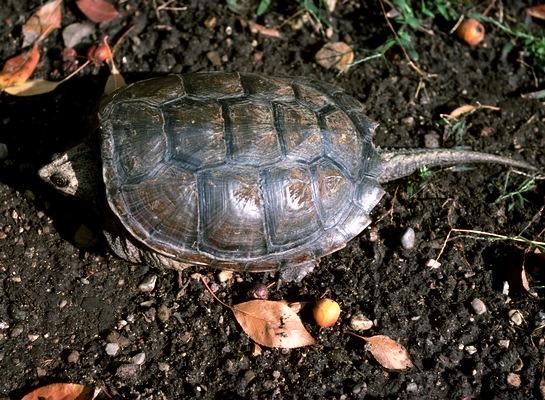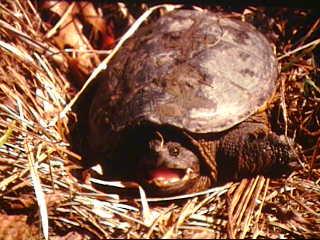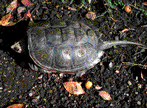In July of 1998 I saw the biggest snapping turtle in my life. It was located adjacent to what we call 'Turtle Pond'. I did free one snapping turtle about three years ago, but this was not the same turtle. This turtle had a shell about 14 inches in diameter. It has obviously moved in from the adjacent river.
![]()
Chelydra serpentina
The Snapping Turtle can grow to a very large size, 20-40 cm on average. It's shell is dark brown, rough and usually covered in algae. The Snapping Turtle can be found in waters ranging from slow moving rivers to stagnate ponds. Although this turtle has received a bad reputation for allegedly biting swimmers and eating baby ducks in reality it is very shy in the water and will retreat from anything except lunch. On land, when threatened it will live up to it's reputation by snapping and hissing while standing on all fours and rocking back and forth. Basically Snapping Turtles eat carrion, their reputation for killing baby ducks could only come from an over abundance or a number of sick baby ducks and only when the Snappers' other food resources are depleted. Looking through articles on the behavior of the snapping turtles if you are still interested in learning more you can head to your local library and rent books related to the topic. Hopefully this will clear up any misunderstandings about the behavior of the snapping turtle.
![]()

![]()

![]()
Snapping turtles are freshwater turtles that live in the Americas. There are three species: the Alligator, Common, and Florida Snapping Turtles. The Alligator snapping turtle is the largest of the North American freshwater turtles. It may be up to 60 cm long and weigh 90 kg!
Snapping Turtles have large heads which cannot be withdrawn into the small shell. They rely on their strong jaws for defense and can bite hard if disturbed. They live in stagnant ponds, swamps and slow-running rivers. Since the Alligator Snapping Turtle lives mainly on fish, it is slaughtered by fishermen and is now on the endangered list.
Common Snapping Turtles can sniff out carrion (dead animals), which they add to their diet of plants, small birds and fish. They are so fearless and aggressive that on occasion, they have been known to attack swimmers. Because of their unique ability to detect dead and rotting flesh, Common Snapping Turtles have been used to help police search for human corpses!
![]()

^ Classification
•Phylum: Chordata •Class: Reptilia •Order: Testudines •Family: Chelydridae
------------------------------------------------------------------------
Table of Contents
•Classification •Geographic Range •Physical Characteristics •Natural History •Conservation/Biodiversity •Economic Benefits for Humans •Other Comments •References •Photos •Image Sources
------------------------------------------------------------------------
^ Geographic Range
Nearctic: The snapping turtle's range stretches from S. Alberta and east to Nova Scotia in the north, extending south all the way to the Gulf of Mexico and into central Texas.
^ Physical Characteristics
Mass: 4.5 to 16 kg
The snapping turtle normally has a shell length ranging from 8 -18 1/2"and has a tail nearly as long as the shell. The tail has saw-toothed keels on it. The shell ranges in color from dark brown to tan and can even be black in some individuals. Snapping turtles have characteristic tubercles on their necks and legs. Plastrons of snapping turtles are very small and leave much of the extremities exposed. Snapping turtle necks, legs, and tails have a yellowish color and the head is dark in color.
^ Natural History
Food Habits
Snapping turtles will eat nearly anything that they can get their jaws around. They feed on carrion, invertebrates, fish, birds, small mammals, amphibians, and a surprisingly large amount of aquatic vegetation. Snapping turtles kill other turtles by decapitation. This behavior might be territoriality towards other turtles or a very inefficient feeding behavior.
Reproduction
Mating takes place from April to November. In the mating process, the male positions himself on top of the female's shell by grasping the shell with his claws. He then curves his tail until his vent contacts the female's vent. Fertilization takes place at this time. After the eggs have developed sufficiently in the female, she excavates a hole, normally in sandy soil, and lays as many as 83 eggs. The eggs take 9-18 weeks to hatch depending on the weather. Interestingly, female snapping turtles sometimes store sperm for several years. Sperm storage allows individuals to mate at any time of the year independent of female ovulation, and it also allows females to lay eggs every season without needing to mate.
Behavior
Snapping turtles are not social creatures. Social interactions are limited to aggressive interactions between individuals, usually males. Many individuals can be found within a small range; snapping turtle density is normally related to the amount of available food. Snapping turtles can be very vicious when removed from the water, but they become docile when placed back into the water. Snapping turtles like to bury themselves in mud with only their nostrils and eyes exposed. This burying behavior is used as a means of ambushing prey. Snapping turtles have a small growth on the front of their tongues that resembles a wriggling worm. To capture fish, the snapping turtle opens its mouth to make the "worm" visible. When a fish comes to investigate the lure, the snapping turtle grabs it with its strong jaws.
Habitat
Snapping turtles only live in fresh or brackish water. They prefer water bodies with muddy bottoms and abundant vegetation because concealment is easier.
Biomes: freshwater lake, freshwater rivers
^ Conservation/Biodiversity
Status: no special status.
Snapping turtle populations are not close to extinction or even threatened. Habitat destruction could pose a danger to snapping turtle populations at a later time. Some individuals are killed for food which does impact the population, but in a very minor way.
^ Economic Benefits for Humans
Positive
Snapping turtles are used by many people in turtle stews and soups. Snapping turtle shells were used in many ceremonies among Native Americans. The shells were dried and mounted on handles with corn kernels inside for use as rattles.
Negative
Snapping turtles consume the young of some game fish. The impact of snapping turtles on these populations is minimal. Snapping turtles are known to kill young and adult ducks and geese, but once again the effects are minimal.
^ Other Comments
--
^ References
Carr, A. 1952. Handbook of Turtles. Comstock Publishing Associates, Ithaca and London.
Conant, R. and Collins, J.T. 1991. A Field Guide to Reptiles and Amphibians. Houghton Mifflin Company, Boston.
Niering, W.A. The Audobon Society Nature Guides, Wetlands. Alfred A. Knopf, Inc. New York.
Porter, K. R. 1972. Herpetology. W.B. Saunders Company, Philidelphia.
Whitfield, Dr. P. editor. 1984. Macmillan Illustrated Animal Encyclopedia. Macmillan Publishing Company, New York.
![]()
![]()
 Wildflower
Seed For Sale
Wildflower
Seed For Sale